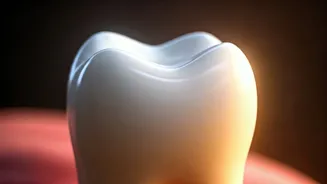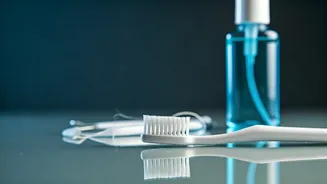Enamel: Tooth's Shield
Enamel, the outermost layer of your teeth, is a remarkable substance. It is the hardest tissue in the human body, primarily composed of minerals, especially
calcium phosphate, arranged in a crystalline structure. This unique composition gives enamel its strength and durability. Its primary function is to protect the underlying dentin and the sensitive pulp, which contains nerves and blood vessels. Enamel forms a barrier against physical damage, such as biting and chewing, and shields the tooth from the constant assault of acids produced by bacteria in the mouth. It is translucent, allowing the underlying dentin to show through and give teeth their color. Without enamel, teeth would be highly vulnerable to wear and tear, decay, and sensitivity, making it essential for overall oral health and function.
Formation and Composition
During tooth development, specialized cells called ameloblasts create enamel. These cells deposit the minerals in a precise pattern, forming the strong crystalline structure. This process occurs before teeth erupt into the mouth. Once the tooth is fully formed, ameloblasts are no longer active, which is why enamel cannot regenerate itself. This makes preventive care and protection even more critical. The minerals in enamel, mainly hydroxyapatite, are extremely resistant to physical and chemical forces. The crystalline structure provides remarkable strength, but it also has microscopic pores that can absorb substances from the environment. These pores are both a strength and a weakness, as they allow for the uptake of fluoride, which strengthens enamel, but also make it susceptible to acid erosion. Understanding the composition and formation process is vital for recognizing the importance of protecting and maintaining enamel health.
Threats to Enamel
Several factors can threaten the integrity of enamel. The most significant threat comes from acids. These acids are produced by bacteria that feed on sugars and carbohydrates in the mouth. The acids demineralize enamel, dissolving the minerals and leading to cavities. Frequent consumption of sugary drinks, processed foods, and snacks can significantly increase acid exposure. Other factors include: tooth grinding (bruxism), which can wear down enamel over time; abrasive brushing techniques with hard-bristled toothbrushes, leading to enamel erosion; and conditions such as gastroesophageal reflux disease (GERD), which brings stomach acid into the mouth. The more one knows the risks, the better they can adjust their habits to safeguard their enamel from harm.
Protecting Your Enamel
Several practices help protect enamel and maintain dental health. Brushing twice daily with fluoride toothpaste is a basic and powerful defense. Fluoride strengthens enamel and makes it more resistant to acid attacks. Proper brushing technique is also essential: use a soft-bristled toothbrush and brush gently. Flossing daily removes food particles and plaque from between teeth, areas that are difficult for brushing to reach, thereby reducing acid production. Limiting sugary foods and drinks reduces the amount of acid produced in the mouth. Drinking water after meals helps neutralize acids and rinse away food particles. Regular dental checkups and professional cleanings are also vital. Dentists can identify early signs of enamel erosion or decay and provide preventive treatments like fluoride varnish applications or recommend dental sealants to protect vulnerable areas of the teeth.
Fluoride's Role
Fluoride is a key element in strengthening and protecting enamel. It works by integrating into the enamel structure, making it more resistant to acid erosion. Fluoride also helps remineralize enamel, repairing early damage caused by acids. Fluoride is available through various sources, including toothpaste, mouthwash, and professionally applied treatments at the dentist's office. The right amount of fluoride exposure depends on age and risk factors. Children are particularly susceptible to the benefits of fluoride, and it is usually safe and effective. Excessive fluoride exposure, especially in children, can lead to dental fluorosis, which causes white spots or discoloration on the teeth. Therefore, using fluoride products and following a dentist's recommendations are essential for proper fluoride use.
Diet and Habits
Dietary choices and oral habits significantly affect enamel health. A diet low in added sugars and refined carbohydrates is beneficial because it limits the fuel supply for acid-producing bacteria. Frequent snacking increases the time teeth are exposed to acids. Instead, opt for whole foods, vegetables, fruits, and lean proteins, which help saliva production, thus neutralizing acids and cleaning the mouth. Avoid excessive consumption of acidic drinks like soda, juices, and sports drinks. If you do consume these, drink them with a meal and follow with water. Certain habits, such as grinding teeth, can wear down enamel. Using a mouthguard at night can protect against this. Tobacco use can also damage enamel and increase the risk of oral health problems. Maintaining a healthy diet and good oral habits supports strong, healthy enamel.











